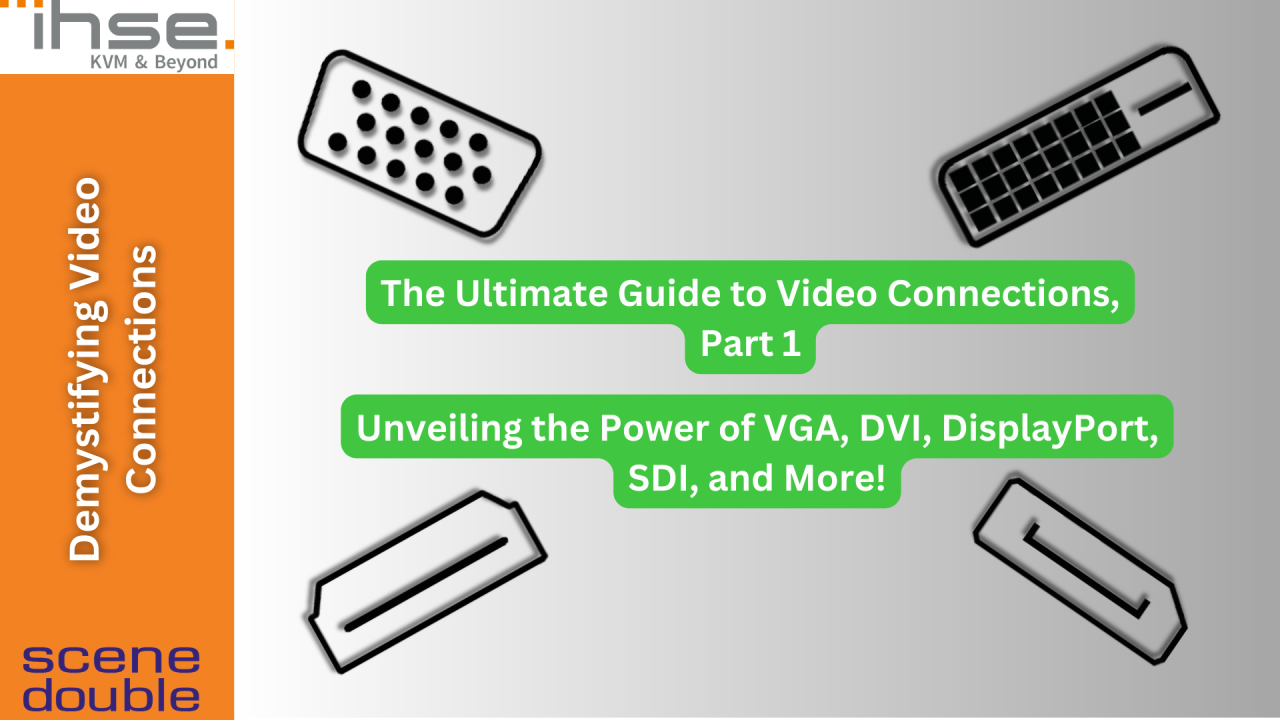
Demystifying Video Connections: Unveiling the Power of VGA, DVI, DisplayPort, SDI, and More!
Are you baffled by the world of video connections? 🤔 Don't worry, we've got you covered!
Part 1 (Part 2 next week ...)
In part 1 of this comprehensive guide, we'll take a deep dive into the realm of VGA, DVI, DisplayPort, SDI, USB-C, and other video connections available on PCs, servers, and more.
Discover the key differences between these connectors and the incredible resolutions they can handle. Get ready to unlock a whole new level of visual excellence! 🖥️💡
When it comes to connecting your devices and harnessing the full potential of your display, understanding the various video connections available is crucial. Let's explore the most commonly used connectors and the resolutions they can handle:
VGA (Video Graphics Array):
VGA, the veteran of video connections, has been around for decades. While it might not offer the highest resolution, it remains widely compatible and accessible.
VGA is capable of handling resolutions up to 1920x1080 (Full HD), making it suitable for general computing tasks and older displays.
The Video Graphics Array (VGA) connector is a standard connector used for computer video output and its 15-pin connector became ubiquitous on PCs and monitors.
Although newer digital interfaces have become standard in most cases, there are still many devices with VGA in use. Examples can be found in many sectors, including Industrial, Maritime and Military environments and many devices are continually manufactured with VGA.
Transfer rates
VGA can support resolutions of up to 2048 × 1536 px (QXGA) @ 85 Hz (388
MHz). Note that VGA is video only and no sound is transmitted.
DVI (Digital Visual Interface):
DVI, the bridge between analogue and digital, offers both digital and analogue signal transmission.
With various DVI formats available, it's essential to choose the right one for your needs.
Single-link DVI supports resolutions up to 1920x1200, while dual-link DVI can handle higher resolutions up to 2560x1600, ideal for professional graphics work.
Digital Visual Interface (DVI) can transmit uncompressed digital video and be configured to support multiple modes such as DVI-A (analogue only), DVI-D (digital only) or DVI-I (digital and analogue).
DVI is backward compatible with displays using analogue VGA signals since some of the contacts in the DVI connector carry the analog VGA signals.

HDMI (High-Definition Multimedia Interface):
HDMI has become the go-to choice for connecting TVs, monitors, and audio-visual equipment. It supports high-definition video and audio signals, making it perfect for home theaters and gaming setups.
HDMI 2.0 and later versions can handle impressive resolutions up to 4K and even 8K, delivering stunning visuals.
High-Definition Multimedia Interface (HDMI) enables the transmission of uncompressed multimedia data in almost perfect quality.
High-resolution video data, HDTV and UHDTV are forwarded in combination with audio data without interference and in high quality via the HDMI interface.

DisplayPort:
DisplayPort, a versatile and future-proof connector, has gained popularity due to its high performance and advanced features.
DisplayPort 1.2 supports resolutions up to 3840x2160 (4K) at 60Hz, while DisplayPort 1.3 and 1.4 can handle resolutions up to 7680x4320 (8K).
In addition to visual signals, DisplayPort cables can also carry audio, USB, and other forms of data simultaneously. To do so DisplayPort relies on packetized data transmission, allowing higher resolution using fewer pins.

The interface is backward compatible with other interfaces, such as HDMI and DVI, through the use of either active or passive adapters.
DisplayPort is also capable of carrying bi-directional USB signals and Multi Stream Transport (MST) for daisy-chaining multiple monitors.
MST supports the extension of two video streams over a single connection cable. Two monitors can then be supplied by daisy chaining.
SDI (Serial Digital Interface):
SDI, widely used in professional video production, offers reliable transmission of high-quality video signals over long distances.
It supports various video resolutions, including SD (Standard Definition), HD (High Definition), and even 4K. SDI is commonly found in broadcasting, live events, and studio setups.
The serial digital interface (SDI) was a common standard for digital video Interfaces and often used for broadcast video where it connects to different pieces of equipment such as recorders, monitors, PCs and vision mixers.
It transmits uncompressed and unencrypted digital video signals (optionally including embedded audio and time code).
Transfer rates
SDI enables transfer rates of 1.485 Gbit/s for HDTV applications and up to 2.97 Gbit/s, with SMPTE ST 424:2012.
USB-C:
USB-C, with its reversible design, has become a ubiquitous connector found on modern devices. In addition to data transfer and charging capabilities, USB-C can also carry video signals.
It supports resolutions up to 4K, making it convenient for connecting laptops, tablets, and smartphones to external displays.
USB-C is the latest and most versatile interface in the USB family and the first interface for high speed data transmission.
In addition to its application on mobile devices, it is commonly used on desktop PCs. The key benefit is its multi signal transport capability including DisplayPort, video, audio and high speed data signals.
Therefore, the use of USB-C interfaces can greatly simplify an installation immensely.
It is also great for “bring your own device” situations and enabling improved ergonomics at workstations by minimizing clutter.
Conclusion:
Understanding the different video connections empowers you to make informed decisions when setting up your PC, connecting to external displays, or upgrading your equipment.
Choose the right connector for your needs, and unlock the full potential of your visual experience!
At Scene Double, our visual collaboration solutions allow you to extend and switch ALL the video signals discussed in this edition.
Remember to like, comment, and share if you found this guide helpful.
Stay tuned for Part 2 next week and more tech insights in our LinkedIn newsletter! 🚀💼
Tempus fugit - Carpe Diem!
10moVery cool 😃
Thanks for Sharing! 😁 Scene Double